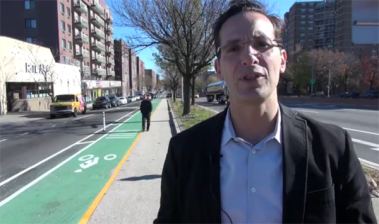Is DOT Setting Up the Amsterdam Avenue Bike Lane to Fail?
Up until a few years ago, when neighborhood residents approached DOT about redesigning a street for greater safety, they expected to get shot down by the agency’s top engineers. In 2004, one former DOT official summed up the department’s attitude as, “We will do pedestrian safety, but only when it doesn’t come at the expense of the flow of traffic.”

DOT has changed since then — there’s a greater recognition that moving cars should not take precedence over safety, economic vitality, and the efficient movement of people. But there are signs the agency is slipping back into old habits.
A test of the department’s commitment to safer street design is imminent on the Upper West Side, where persistent advocacy by local residents finally convinced DOT to develop a plan for a protected bike lane and pedestrian islands on Amsterdam Avenue. DOT is expected to present the plan to Community Board 7 in the near future. The trouble is, agency officials are talking as if they’ll frame the project as a choice between safety and traffic flow. That would be a page out of the old DOT playbook and a huge step backward.
When Transportation Commissioner Polly Trottenberg said DOT will come out with a plan for Amsterdam Avenue this fall, she added some caveats. “Amsterdam Avenue is challenging… Just the way the traffic moves and the configuration of the roadway do make it a more challenging road to redesign [than Columbus Avenue],” she said. “But we’re going to come up with some plans and we’re going to lay them out for the community board and for everyone who’s interested.”
Then at a press event late last month, DOT Deputy Commissioner Ryan Russo spoke candidly with me about how he views the politics of expanding the city’s bike network. At one point the conversation turned to the Upper West Side, where the agency had to be cajoled into proposing better bike lanes at the bowtie intersection of Broadway and Columbus Avenue last year. Russo defended the absence of bike lanes in DOT’s road diet plan for West End Avenue, saying they wouldn’t have been supported by residents of “green awning buildings” and local Council Member Helen Rosenthal.
I asked Russo why, in that case, Rosenthal is backing a protected bike lane on Amsterdam Avenue. “I don’t know. She hasn’t seen the numbers yet,” he said with a laugh. What numbers? “Our analysis,” he replied. “We’re going to bring it to the community board and explain to people what the implications are, like the commissioner said.”
The implication is that DOT expects Rosenthal and CB 7’s support to wither after the agency presents its plan. And if DOT trots out traffic models that predict carmageddon when Amsterdam has a protected bike lane and one less car lane, the agency will certainly be leading the conversation in that direction.
Although CB 7 has requested protected bike lanes on Amsterdam multiple times, bike lanes have faced consistent opposition from transportation committee co-chairs, Andrew Albert and Dan Zweig. “There is very heavy traffic and it is a truck route,” Zweig, a Rosenthal appointee, told the Post last month. “We don’t know if Amsterdam Avenue can accommodate a bike lane.”
Presenting an Amsterdam Avenue bikeway as a choice between safety and congestion would be troubling for several reasons. One is that traffic models are notoriously inaccurate and fail to account for the complexity of people’s travel decisions. A famous example that Upper West Siders will be familiar with: DOT traffic engineers insisted for years that restricting cars in Central Park would lead to intolerable spillover traffic on other streets, but whenever the city actually expands car-free hours, the traffic nightmare on neighborhood streets never materializes.
On Amsterdam Avenue, it’s not hard to see how traffic would settle in to a new equilibrium once the bike lane is in place. Fewer drivers may choose to use Amsterdam once they realize it’s no longer a speedway out of town. They’ll opt for the highway, where they belong. If DOT is still worried about traffic, the avenue’s curb regulations are begging for an update. Instead of equivocating on a critical safety project, the agency should tackle Amsterdam’s lack of loading zones and demand-responsive parking meter prices.
The fact is, much of the day, traffic congestion already isn’t a problem on Amsterdam. During off-peak hours, drivers regularly exceed the 25 mph speed limit — this is what DOT should be focused on fixing. Citywide, speed is the leading cause of fatal crashes, so it’s no coincidence that Amsterdam is one of the most dangerous streets on the Upper West Side.
And that brings us to the biggest red flag in Russo’s comments. The fundamental premise of Vision Zero, the street safety philosophy that purportedly guides DOT’s decisions, is that public officials have a moral obligation to prevent traffic deaths and injuries. On Amsterdam, narrowing the roadway to make room for a protected bike lane is going to make a big difference for safety, and DOT knows it. Traffic models are no excuse to go soft on a redesign that will save lives.
